I. Project structure
1. Project structure:
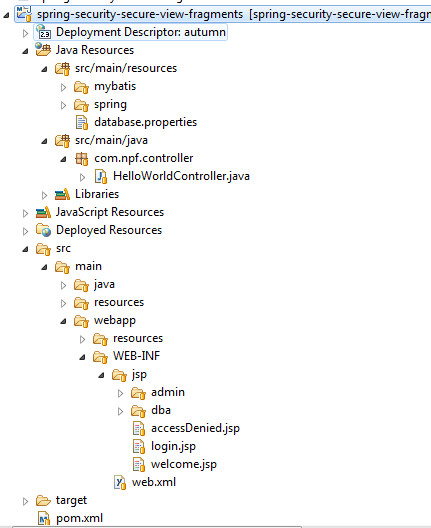
2.
The pom.xml file is as follows:
<project xmlns="http://maven.apache.org/POM/4.0.0" xmlns:xsi="http://www.w3.org/2001/XMLSchema-instance"
xsi:schemaLocation="http://maven.apache.org/POM/4.0.0 http://maven.apache.org/maven-v4_0_0.xsd">
<modelVersion>4.0.0</modelVersion>
<groupId>com.npf</groupId>
<artifactId>spring-security-secure-view-fragments</artifactId>
<packaging>war</packaging>
<version>0.0.1-SNAPSHOT</version>
<name>spring-security-secure-view-fragments Maven Webapp</name>
<url>http://maven.apache.org</url>
<properties>
<spring.version>4.1.6.RELEASE</spring.version>
<project.build.sourceEncoding>UTF-8</project.build.sourceEncoding>
</properties>
<dependencies>
<dependency>
<groupId>junit</groupId>
<artifactId>junit</artifactId>
<version>4.10</version>
<scope>test</scope>
</dependency>
<dependency>
<groupId>junit</groupId>
<artifactId>junit</artifactId>
<version>4.10</version>
<scope>test</scope>
</dependency>
<dependency>
<groupId>org.springframework</groupId>
<artifactId>spring-webmvc</artifactId>
<version>${spring.version}</version>
</dependency>
<dependency>
<groupId>org.springframework</groupId>
<artifactId>spring-jdbc</artifactId>
<version>${spring.version}</version>
</dependency>
<dependency>
<groupId>commons-logging</groupId>
<artifactId>commons-logging</artifactId>
<version>1.2</version>
</dependency>
<dependency>
<groupId>jstl</groupId>
<artifactId>jstl</artifactId>
<version>1.2</version>
</dependency>
<dependency>
<groupId>org.mybatis</groupId>
<artifactId>mybatis-spring</artifactId>
<version>1.3.0</version>
</dependency>
<dependency>
<groupId>org.mybatis</groupId>
<artifactId>mybatis</artifactId>
<version>3.4.0</version>
</dependency>
<dependency>
<groupId>mysql</groupId>
<artifactId>mysql-connector-java</artifactId>
<version>5.1.30</version>
</dependency>
<dependency>
<groupId>commons-dbcp</groupId>
<artifactId>commons-dbcp</artifactId>
<version>1.4</version>
</dependency>
<dependency>
<groupId>commons-io</groupId>
<artifactId>commons-io</artifactId>
<version>2.5</version>
</dependency>
<dependency>
<groupId>commons-fileupload</groupId>
<artifactId>commons-fileupload</artifactId>
<version>1.3.2</version>
</dependency>
<dependency>
<groupId>org.springframework.security</groupId>
<artifactId>spring-security-web</artifactId>
<version>4.0.1.RELEASE</version>
</dependency>
<dependency>
<groupId>org.springframework.security</groupId>
<artifactId>spring-security-config</artifactId>
<version>4.0.1.RELEASE</version>
</dependency>
<dependency>
<groupId>org.springframework.security</groupId>
<artifactId>spring-security-taglibs</artifactId>
<version>4.0.1.RELEASE</version>
</dependency>
</dependencies>
<profiles>
<profile>
<id>jdk-1.7</id>
<activation>
<activeByDefault>true</activeByDefault>
<jdk>1.7</jdk>
</activation>
<properties>
<maven.compiler.source>1.7</maven.compiler.source>
<maven.compiler.target>1.7</maven.compiler.target>
<maven.compiler.compilerVersion>1.7</maven.compiler.compilerVersion>
</properties>
</profile>
</profiles>
<build>
<finalName>spring-security-secure-view-fragments</finalName>
</build>
</project>
<?xml version="1.0" encoding="UTF-8"?>
<beans:beans xmlns="http://www.springframework.org/schema/security"
xmlns:beans="http://www.springframework.org/schema/beans"
xmlns:xsi="http://www.w3.org/2001/XMLSchema-instance"
xsi:schemaLocation="http://www.springframework.org/schema/beans
http://www.springframework.org/schema/beans/spring-beans-4.1.xsd
http://www.springframework.org/schema/security
http://www.springframework.org/schema/security/spring-security-4.0.xsd">
<beans:bean id="securityContextLogoutHandle"
class="org.springframework.security.web.authentication.logout.SecurityContextLogoutHandler"/>
<http auto-config="true" use-expressions="true">
<intercept-url pattern="/" access="hasRole('ADMIN') or hasRole('DBA') or hasRole('USER')" />
<intercept-url pattern="/home" access="hasRole('ADMIN') or hasRole('DBA') or hasRole('USER')" />
<intercept-url pattern="/admin/**" access="hasRole('ADMIN')" />
<intercept-url pattern="/dba/**" access="hasRole('ADMIN') and hasRole('DBA')" />
<access-denied-handler error-page="/accessDenied"/>
<form-login login-page="/login"
username-parameter="ssoId"
password-parameter="password"
login-processing-url="/login"
authentication-failure-url="/authenticationFailure"/>
</http>
<authentication-manager >
<authentication-provider>
<user-service>
<user name="jack" password="jack123" authorities="ROLE_USER" />
<user name="admin" password="admin123" authorities="ROLE_ADMIN" />
<user name="dbaOnly" password="dba123" authorities="ROLE_DBA" />
<user name="dba" password="dba123" authorities="ROLE_ADMIN,ROLE_DBA" />
</user-service>
</authentication-provider>
</authentication-manager>
</beans:beans>5. HelloWorldController:<filter> <filter-name>springSecurityFilterChain</filter-name> <filter-class>org.springframework.web.filter.DelegatingFilterProxy</filter-class> </filter> <filter-mapping> <filter-name>springSecurityFilterChain</filter-name> <url-pattern>/*</url-pattern> </filter-mapping>
package com.npf.controller;
import javax.servlet.http.HttpServletRequest;
import javax.servlet.http.HttpServletResponse;
import org.springframework.beans.factory.annotation.Autowired;
import org.springframework.security.core.Authentication;
import org.springframework.security.core.context.SecurityContextHolder;
import org.springframework.security.core.userdetails.UserDetails;
import org.springframework.security.web.authentication.logout.SecurityContextLogoutHandler;
import org.springframework.stereotype.Controller;
import org.springframework.ui.ModelMap;
import org.springframework.web.bind.annotation.RequestMapping;
import org.springframework.web.bind.annotation.RequestMethod;
@Controller
public class HelloWorldController {
@Autowired
private SecurityContextLogoutHandler securityContextLogoutHandle;
@RequestMapping(value = {"/home","/"}, method = RequestMethod.GET)
public String homePage(ModelMap model) {
Object principal = SecurityContextHolder.getContext().getAuthentication().getPrincipal();
String userName = principal instanceof UserDetails ? ((UserDetails) principal)
.getUsername() : principal.toString();
model.addAttribute("user", userName);
return "welcome";
}
@RequestMapping(value = "/admin/index", method = RequestMethod.GET)
public String adminPage(ModelMap model) {
Object principal = SecurityContextHolder.getContext().getAuthentication().getPrincipal();
String userName = principal instanceof UserDetails ? ((UserDetails) principal)
.getUsername() : principal.toString();
model.addAttribute("user", userName);
return "admin/index";
}
@RequestMapping(value = "/dba/index", method = RequestMethod.GET)
public String dbaPage(ModelMap model) {
Object principal = SecurityContextHolder.getContext().getAuthentication().getPrincipal();
String userName = principal instanceof UserDetails ? ((UserDetails) principal)
.getUsername() : principal.toString();
model.addAttribute("user", userName);
return "dba/index";
}
@RequestMapping(value = "/login", method = RequestMethod.GET)
public String loginPage() {
return "login";
}
@RequestMapping(value = "/logout", method = RequestMethod.GET)
public String logoutPage(HttpServletRequest request,HttpServletResponse response) {
Authentication auth = SecurityContextHolder.getContext().getAuthentication();
if (auth != null) {
securityContextLogoutHandle.logout(request, response, auth);
}
return "redirect:/home";
}
@RequestMapping(value = "/accessDenied", method = RequestMethod.GET)
public String accessDeniedPage(ModelMap model) {
Object principal = SecurityContextHolder.getContext().getAuthentication().getPrincipal();
String userName = principal instanceof UserDetails ? ((UserDetails) principal)
.getUsername() : principal.toString();
model.addAttribute("user", userName);
return "accessDenied";
}
@RequestMapping(value = "/authenticationFailure", method = RequestMethod.GET)
public String authenticationFailure(HttpServletRequest request){
request.setAttribute("authenticationFailureResult", "failure");
return "login";
}
}Two, test
1. Visit home page: http://localhost:8080/spring-security-secure-view-fragments/Because there is no access to the home page, it is directed to the login page:
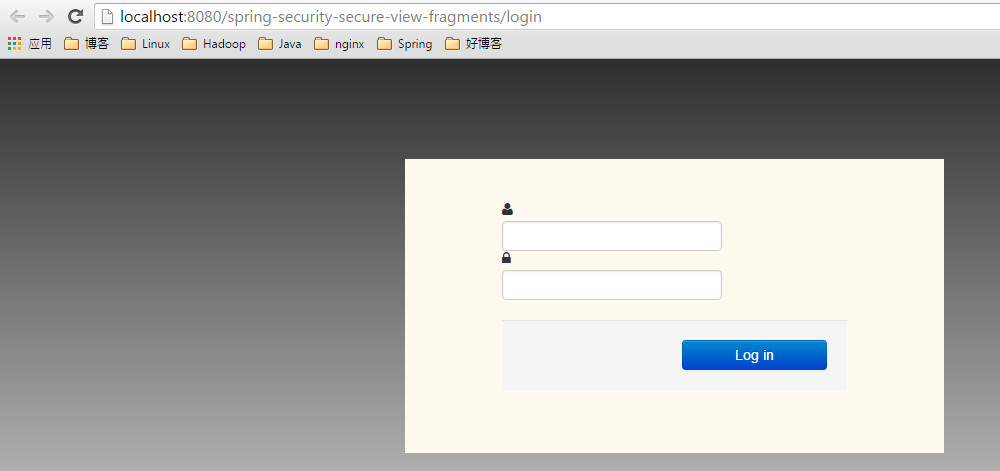
2. The test has "USER" permission:
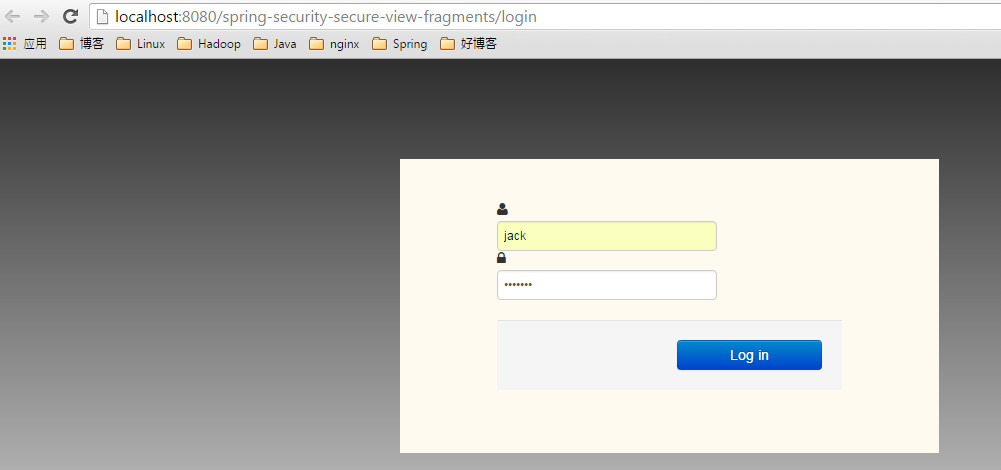
After successful login, you will see:

3. Exit, test has "ADMIN" authority:
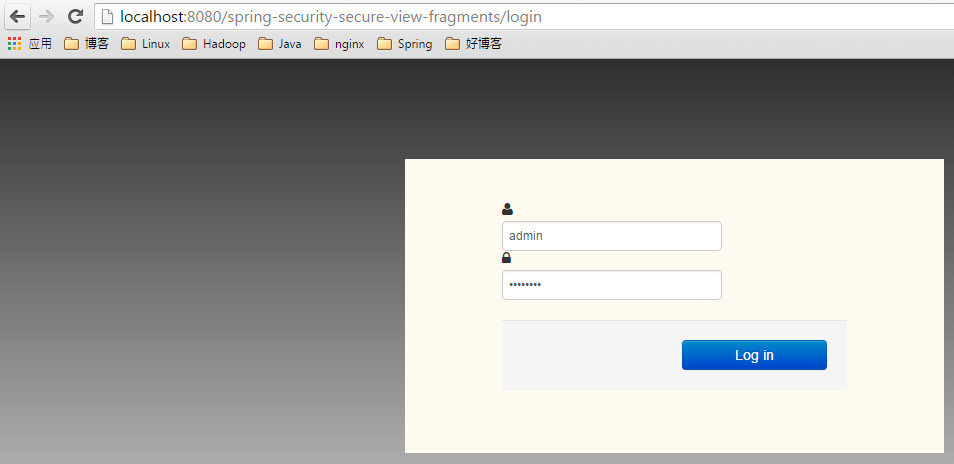
After successful login, you will see:

4. Exit, test has "DBA" permission:
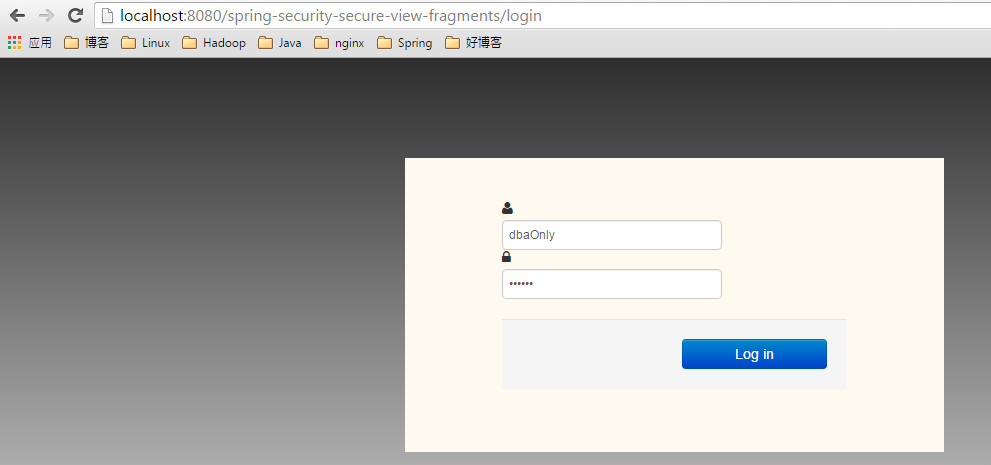
After successful login, you will see:

5. Exit, test has "DBA"
And "ADMIN" permissions:
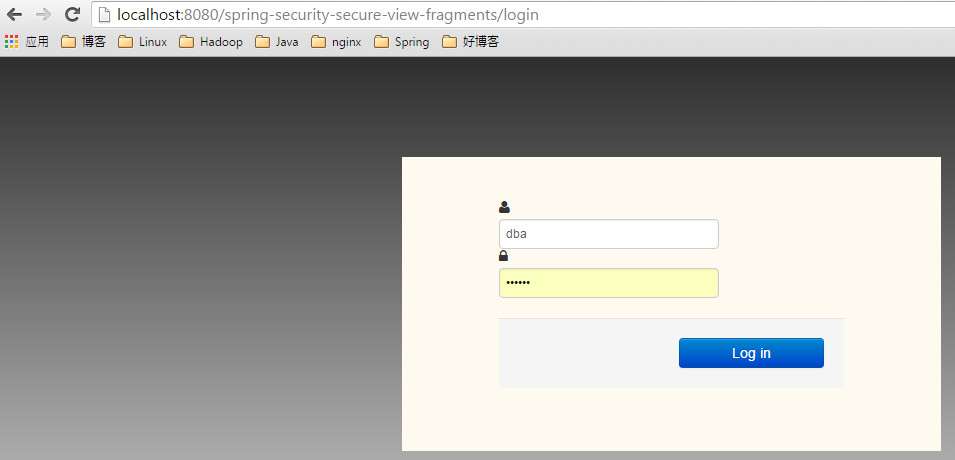
After successful login, you will see:

The source code address of the project: https://github.com/spring-security/spring-security-secure-view-fragments
Reference: